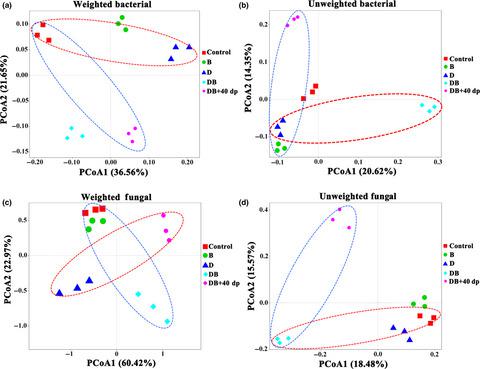当前位置:
X-MOL 学术
›
Microbiologyopen
›
论文详情
Our official English website, www.x-mol.net, welcomes your feedback! (Note: you will need to create a separate account there.)
Deep tillage combined with biofertilizer following soil fumigation improved chrysanthemum growth by regulating the soil microbiome.
MicrobiologyOpen ( IF 3.4 ) Pub Date : 2020-04-23 , DOI: 10.1002/mbo3.1045 Huijie Chen 1 , Shuang Zhao 1 , Jiamiao Zhao 1 , Kaikai Zhang 1 , Jing Jiang 1 , Zhiyong Guan 1 , Sumei Chen 1 , Fadi Chen 1 , Weimin Fang 1
MicrobiologyOpen ( IF 3.4 ) Pub Date : 2020-04-23 , DOI: 10.1002/mbo3.1045 Huijie Chen 1 , Shuang Zhao 1 , Jiamiao Zhao 1 , Kaikai Zhang 1 , Jing Jiang 1 , Zhiyong Guan 1 , Sumei Chen 1 , Fadi Chen 1 , Weimin Fang 1
Affiliation

|
Sustained monoculture often leads to the inhibition of plant growth, the decrease of the soil microbial diversity, and changes in soil microbial community composition, particularly to the accumulation of soil‐borne pathogens. In this study, we conducted field experiments to investigate the practical effects of tilling the soil down to a depth of 40 cm (40dp) in combination with dazomet (D) soil fumigation and/or the application of a bio‐organic fertilizer (B) on chrysanthemum growth, with a focus on the potential mechanisms underlying the responses of the soil microbiome. The growth indices of chrysanthemum were significantly (p < .05) increased in the DB + 40dp treatment compared to that in other treatments. The weighted and unweighted UniFrac distances in the principal coordinate analysis (PCoA) revealed that soil bacterial and fungal community compositions were separated according to the treatments. The abundance of genera potentially expressing growth promotion, such as Pseudomonas and Bacillus, was increased in the DB + 40dp treatment. In addition, the combined DB + 40dp treatment enhanced the activities of catalase, urease, sucrase, and β‐d‐glucosidase, and significantly increased the levels of available nitrogen, phosphorus, and potassium in the soil. The redundancy analysis (RDA) implied that the composition of the microbiome was correlated to soil enzymatic activities and soil potassium availability in the rhizosphere soil of chrysanthemum plants. Our findings suggest that the DB + 40dp treatment is a better strategy for improving chrysanthemum growth and regulating the rhizosphere microbiome in monoculture soils than the methods presently employed by commercial chrysanthemum producers.
中文翻译:

熏蒸后深耕与生物肥料的结合通过调节土壤微生物组改善了菊花的生长。
持续的单一栽培通常会导致植物生长受到抑制,土壤微生物多样性降低以及土壤微生物群落组成发生变化,特别是导致土壤传播的病原体积累。在这项研究中,我们进行了田间试验,以研究将土壤深耕至40 cm(40dp)的深层土壤,并与达唑麦特(D)熏蒸和/或施用生物有机肥料(B)结合使用的实际效果。关于菊花的生长,重点是土壤微生物组响应的潜在机制。菊花的生长指数显着(p 与其他处理相比,DB + 40dp处理增加了<0.05。主坐标分析(PCoA)中的加权和未加权UniFrac距离显示,土壤细菌和真菌群落组成根据处理方法是分开的。在DB + 40dp处理中,可能表达生长促进作用的属(如假单胞菌和芽孢杆菌)的数量增加了。此外,DB + 40dp联合处理可增强过氧化氢酶,脲酶,蔗糖酶和β- d的活性。葡萄糖苷酶,并显着增加了土壤中有效氮,磷和钾的含量。冗余分析(RDA)暗示了微生物组的组成与菊花植物根际土壤中的酶活性和钾有效性相关。我们的发现表明,与目前商业菊生产者采用的方法相比,DB + 40dp处理是一种改善菊花生长和调节单培养土壤中根际微生物组的更好策略。
更新日期:2020-04-23
中文翻译:

熏蒸后深耕与生物肥料的结合通过调节土壤微生物组改善了菊花的生长。
持续的单一栽培通常会导致植物生长受到抑制,土壤微生物多样性降低以及土壤微生物群落组成发生变化,特别是导致土壤传播的病原体积累。在这项研究中,我们进行了田间试验,以研究将土壤深耕至40 cm(40dp)的深层土壤,并与达唑麦特(D)熏蒸和/或施用生物有机肥料(B)结合使用的实际效果。关于菊花的生长,重点是土壤微生物组响应的潜在机制。菊花的生长指数显着(p 与其他处理相比,DB + 40dp处理增加了<0.05。主坐标分析(PCoA)中的加权和未加权UniFrac距离显示,土壤细菌和真菌群落组成根据处理方法是分开的。在DB + 40dp处理中,可能表达生长促进作用的属(如假单胞菌和芽孢杆菌)的数量增加了。此外,DB + 40dp联合处理可增强过氧化氢酶,脲酶,蔗糖酶和β- d的活性。葡萄糖苷酶,并显着增加了土壤中有效氮,磷和钾的含量。冗余分析(RDA)暗示了微生物组的组成与菊花植物根际土壤中的酶活性和钾有效性相关。我们的发现表明,与目前商业菊生产者采用的方法相比,DB + 40dp处理是一种改善菊花生长和调节单培养土壤中根际微生物组的更好策略。



























 京公网安备 11010802027423号
京公网安备 11010802027423号